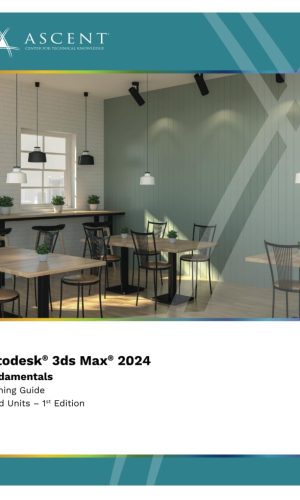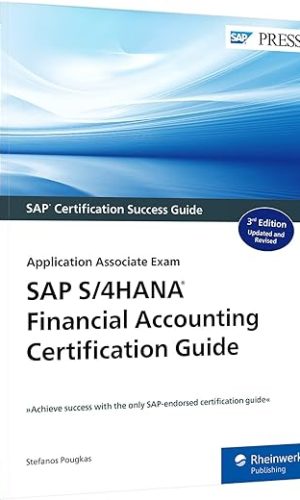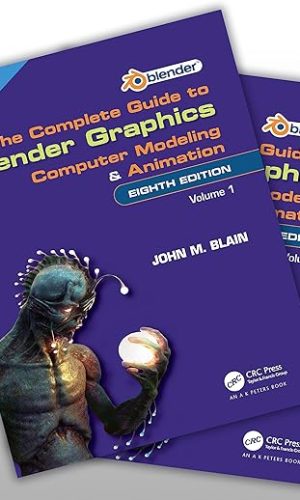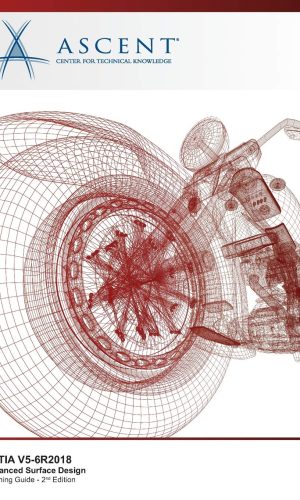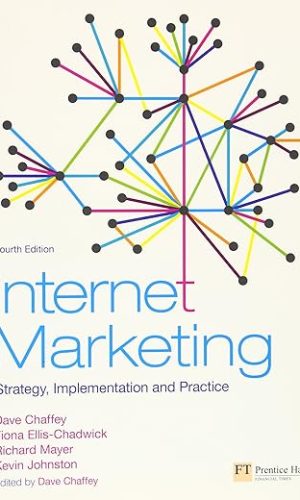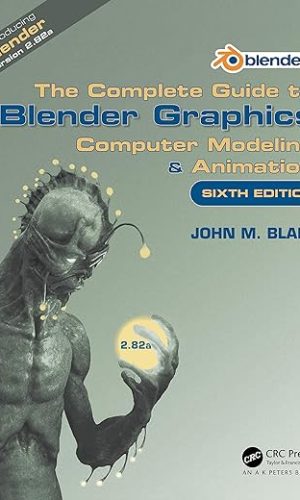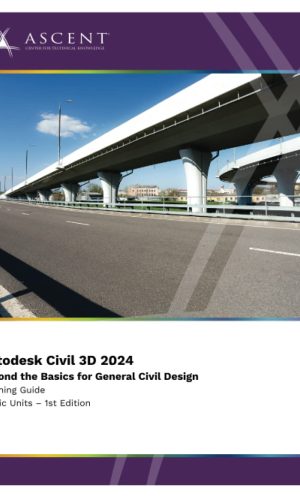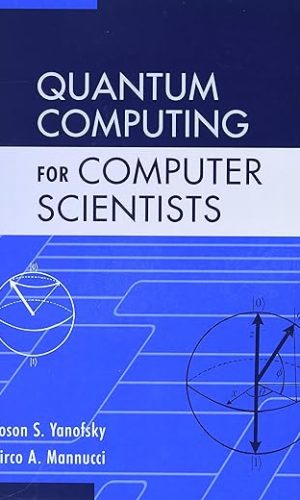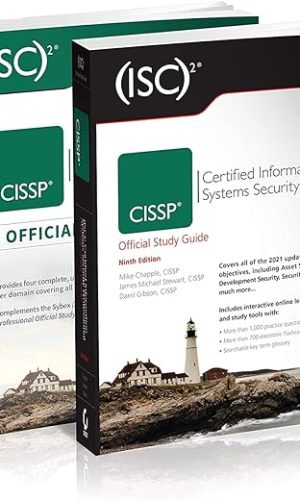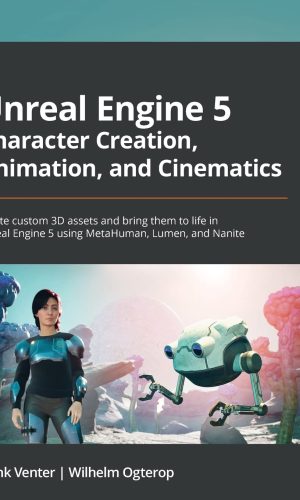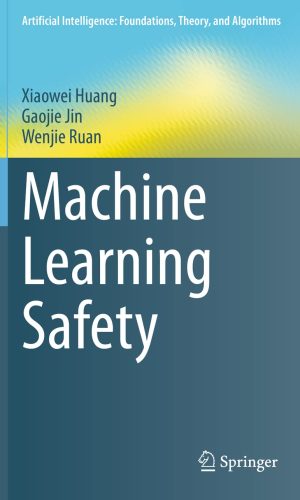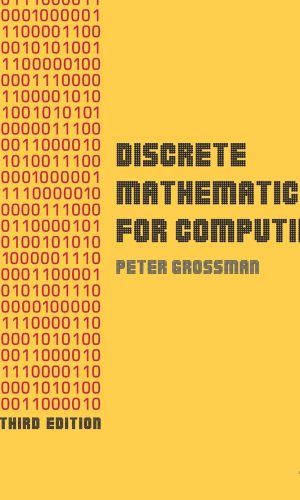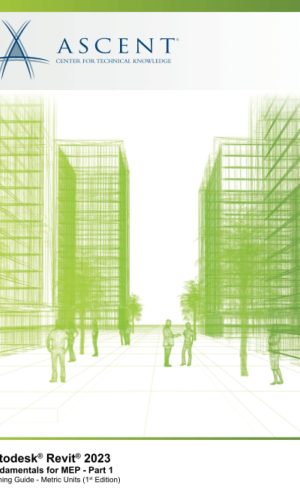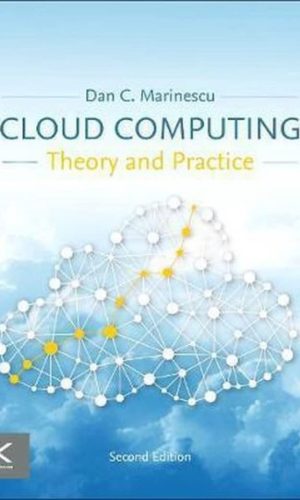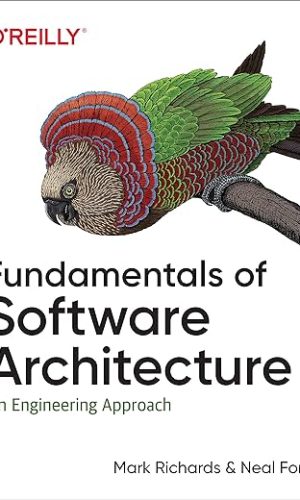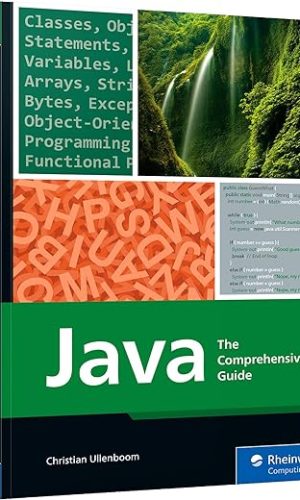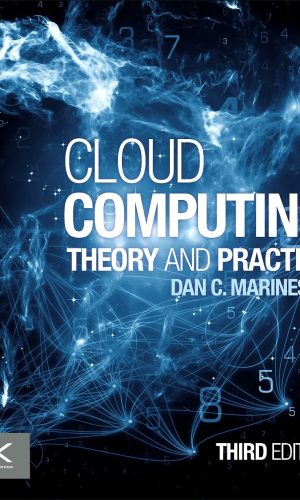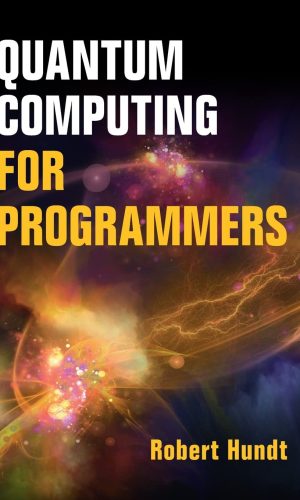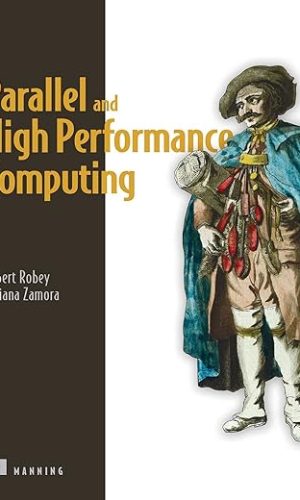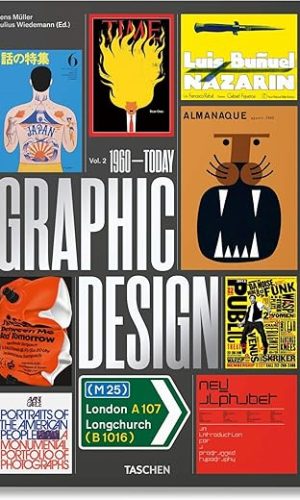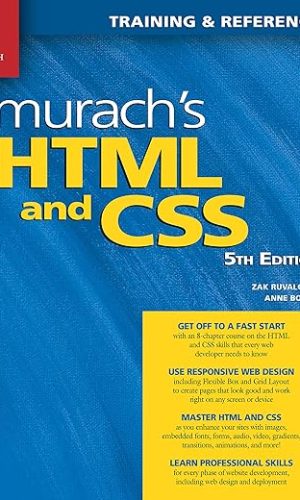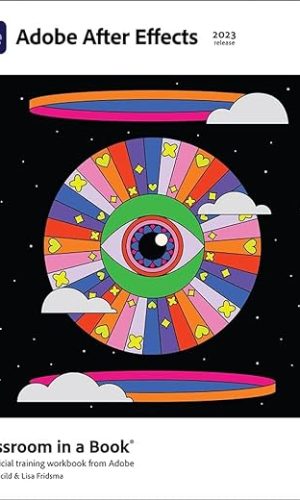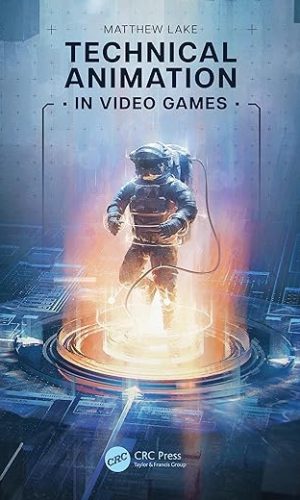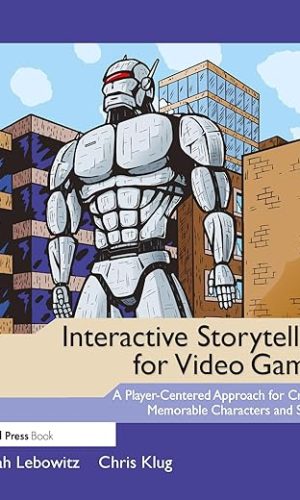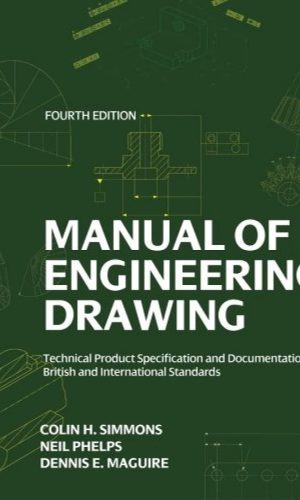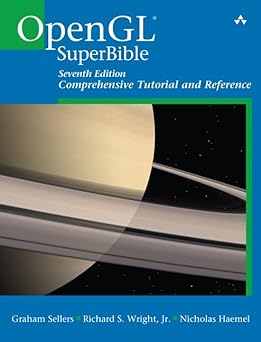-
The Complete Guide to Blender Graphics: Computer Modeling & Animation
BlenderTM is a free Open Source 3D Computer Modeling and Animation Suite incorporating Character Rigging, Particles, Real World Physics Simulation, Sculpting, Video Editing with Motion Tracking and 2D Animation within the 3D Environment.
Blender is FREE to download and use by anyone for anything.
The Complete Guide to Blender Graphics: Computer Modeling and Animation, Seventh Edition is a unified manual describing the operation of the program with reference to the Graphical User Interface for Blender Version 3.0.0, including nearly 100 pages of completely new content.
The book introduces the program’s Graphical User Interface and shows how to implement tools for modeling and animating characters and created scenes with the application of color, texture and special lighting effects.
Key Features:
- The book provides instruction for New Users starting at the very beginning.
- Instruction is presented in a series of chapters incorporating visual reference to the program’s interface.
- The initial chapters are designed to instruct the user in the operation of the program while introducing and demonstrating interesting features of the program.
- Chapters are developed in a building block fashion providing forward and reverse reference to relevant material.
The book is also available in a discounted set along with Blender 2D Animation: The Complete Guide to the Grease Pencil.
Read more
£142.50 -
Autodesk 3ds Max 2024: Fundamentals (Mixed Units)
The Autodesk® 3ds Max® 2024: Fundamentals guide provides a thorough introduction to the Autodesk 3ds Max 2024 software that will help new users make the most of this sophisticated application, as well as broaden the horizons of existing, self-taught users. The guide instructs you on how to effectively use the software interface and navigate through the scenes. It explores the creation of 3D objects and how to bring in objects from other software such as Autodesk Revit, AutoCAD, and Civil 3D. Additionally, it teaches you to prepare the scenes for renderings by adding materials, lights, and cameras. Finally, the guide covers an understanding of various renderers included with the software, as well as image creation and animation techniques.
The practices in this guide are primarily geared towards real-world tasks encountered by users of the Autodesk 3ds Max software in the Architecture, Interior Design, and Civil Engineering industries. Advanced topics such as character modeling, character animation, and rigging are not covered in this guide.
Topics Covered
- Autodesk 3ds Max interface and workflow
- Assembling files by importing, linking, or merging
- 3D modeling with primitives and 2D objects
- Using modifiers to create and modify 3D objects
- Materials and maps
- Autodesk 3ds Max lighting
- Working with cameras and exposure control
- Rendering using various renderers, such as Scanline, ART, and Arnold
- Animation for visualization
Prerequisites
- Access to the 2024.0 version of the software, to ensure compatibility with this guide. Future software updates that are released by Autodesk may include changes that are not reflected in this guide. The practices and files included with this guide might not be compatible with prior versions (e.g., 2023).
- Experience with 3D modeling is recommended.
Read more
£86.50 -
Autodesk Revit 2023: Fundamentals for Structure (Metric Units): Autodesk Authorized Publisher
To take full advantage of Building Information Modeling, the Autodesk® Revit® 2023: Fundamentals for Structure guide has been designed to teach the concepts and principles of creating 3D parametric models of structural buildings from engineering design through construction documentation.
This guide is intended to introduce you to the user interface and the basic building components of the software that makes Autodesk® Revit® a powerful and flexible structural modeling tool. The goal is to familiarize you with the tools required to create, modify, analyze, and document a parametric model. The examples and practices are designed to take you through the basics of a full structural project, from linking in an architectural model to construction documents.
Topics Covered
- Introduction to the Autodesk Revit software.
- Navigating the Revit workspace and interface.
- Working with the basic sketching and modifying tools.
- Creating levels and grids as datum elements for the model.
- Understanding Revit families and components.
- Understanding the project browser and working with views.
- Starting a structural project based on a linked architectural model.
- Creating a 3D building model.
- Adding structural columns and walls.
- Adding foundations and structural slabs.
- Structural reinforcement.
- Beams, trusses, and framing systems.
- Analytical models and placing loads.
- Project practices to reinforce learning.
- Setting up sheets for plotting with text, dimensions, details, tags, and schedules.
- Creating details.
Prerequisites
- Access to the 2023.0 version of the software, to ensure compatibility with this guide. Future software updates that are released by Autodesk may include changes that are not reflected in this guide. The practices and files included with this guide might not be compatible with prior versions (e.g., 2022).
- This guide introduces the fundamental skills in learning how to use the Autodesk Revit software, with a focus on the structural tools. It is highly recommended that students have experience and knowledge in structural engineering and its terminology.
Read more
£83.90 -
Autodesk Revit 2024: Fundamentals for Structure (Metric Units)
To take full advantage of Building Information Modeling, the Autodesk® Revit® 2024: Fundamentals for Structure guide has been designed to teach the concepts and principles of creating 3D parametric models of structural buildings from engineering design through construction documentation.
This guide is intended to introduce you to the user interface and the basic building components of the software that makes Autodesk® Revit® a powerful and flexible structural modeling tool. The goal is to familiarize you with the tools required to create, modify, analyze, and document a parametric model. The examples and practices are designed to take you through the basics of a full structural project, from linking in an architectural model to construction documents.
Topics Covered
- Introduction to the Autodesk Revit software, including navigating the Revit interface
- Starting a structural project based on a linked architectural model and creating levels and grids as datum elements for the model
- Understanding the project browser and working with views
- Understanding Revit families and components
- Working with the basic sketching and modifying tools
- Adding structural columns to a project and copying and monitoring elements from linked models
- Adding foundations and footings
- Creating structural framing, including beams, trusses, and framing systems
- Creating slabs for foundations, structural floors, and roofs
- Creating structural reinforcement, including placing rebar and adding fabric reinforcement
- Setting up sheets and placing and modifying views on sheets
- Working with dimensions, text, annotations, and legends
- Adding tags and working with schedules
- Setting up detail views and adding detail components
Prerequisites
- Access to the 2024.0 version of the software, to ensure compatibility with this guide. Future software updates that are released by Autodesk may include changes that are not reflected in this guide. The practices and files included with this guide might not be compatible with prior versions (e.g., 2023).
- This guide introduces the fundamental skills in learning how to use the Autodesk Revit software, with a focus on the structural tools. It is highly recommended that students have experience and knowledge in structural engineering and its terminology.
Read more
£82.90 -
Quantum Computing (Second Edition): A pathway to quantum logic design (IOP ebooks)
Quantum computing is an emerging technology with the potential to have a significant impact on science and technology. Organised into four parts, this comprehensive second edition covers topics such as the basic concepts of quantum computing alongside quantum implementation of different circuits; the fault tolerant concepts of quantum computing; the concept of QCA alongside the design processes of different QCA circuits; and an overview of QCA fault-tolerant circuits and their design procedures. In addition to updates to first edition chapters to reflect developments in recent years, this new edition sees the inclusion of problems to every chapter and eight new chapters. This book will be a great help for quantum computing researchers, faculty members and students who can develop a working understanding of circuit-based quantum computing.
Key Features
- Contains eight new chapters as a significantly extended new edition
- Encompasses developments in the area, with a special focus on quantum cellular automata
- Is suitable as a supplementary text in advanced courses
- Includes problems within every chapter
Read more
£82.10£114.00 -
SAP S/4HANA Financial Accounting Certification Guide: Application Associate Exam
Preparing for your financial accounting exam? Make the grade with this SAP S/4HANA 1909 and 2020 certification study guide! From general ledger accounting to financial closing, this guide reviews the key technical and functional knowledge you need to get a high score on your SAP S/4HANA for Financial Accounting Associates exam. Explore test methodology, key concepts for each topic area, and practice questions and answers. Your path to financial accounting certification begins here! Highlights Include: 1) Exam C_TS4FI_1909 2) Exam C_TS4FI_2020 3) Deployment 4) General ledger accounting 5) Accounts payable (AP) 6) Accounts receivable (AR) 7) Asset accounting 8) Financial closing 9) Document parking 10) Validations and substitutions 11) Bank account managementRead more
£81.70 -
Technical Drawing with Engineering Graphics
This full-color text offers a clear, complete introduction and detailed reference for creating 3D models and 2D documentation drawings. Building on its reputation as a trusted reference, this edition expands on the role that 3D CAD databases now play in design and documentation. Superbly integrated illustrations, text, step-by-step instructions, and navigation make it easier than ever to master key skills and knowledge. Throughout, the authors demonstrate 3D and 2D drawing skills and CAD usage in real-world work practice in today’s leading disciplines. They combine strong technical detail, real-world examples, and current standards, materials, industries, and processes-all in a format that is efficient, colorful, and visual.
Features:- Splash Spread: Appealing chapter opener provides context and motivation.
- References and Web Links: Useful weblinks and standards provided upfront in each chapter.
- Understanding Section: Foundational introductions, tabbed for easy navigation, outline each topic’s importance, use, visualization tips, and theory.
- Detail Section: Detailed, well-tested explanations of drawing techniques, variations, and examples-organized into quick-read sections, numbered for easy reference.
- CAD at Work Section: Breakout pages offer tips on generating drawings from 2D or 3D models.
- Portfolio Section: Examples of finished drawings show how techniques are applied in the real world.
- Key Words: Italicized on first reference, summarized after each chapter.
- Chapter: Summaries and Review Questions: Efficiently reinforce learning.
- Exercises: Outstanding problem sets with updated exercises, including parts, assembly drawings from CAD models, sketching problems, and orthographic projections.
Read more
£80.70 -
The Complete Guide to Blender Graphics: Computer Modeling and Animation: Volumes One and Two: 1-2
BlenderTM is a free Open-Source 3D Computer Modeling and Animation Suite incorporating Character Rigging, Particles, Real World Physics Simulation, Sculpting, Video Editing with Motion Tracking and 2D Animation within the 3D Environment.
Blender is FREE to download and use by anyone for anything.
The Complete Guide to Blender Graphics: Computer Modeling and Animation, Eighth Edition is a unified manual describing the operation of the program, updated with reference to the Graphical User Interface for Blender Version 3.2.2, including additional material covering Blender Assets, Geometry Nodes, and Non-Linear Animation.
Divided into a two-volume set, the book introduces the program’s Graphical User Interface and shows how to implement tools for modeling and animating characters and created scenes with the application of color, texture, and special lighting effects.
Key Features:
- The book provides instruction for New Users starting at the very beginning.
- Instruction is presented in a series of chapters incorporating visual reference to the program’s interface.
- The initial chapters are designed to instruct the user in the operation of the program while introducing and demonstrating interesting features of the program.
- Chapters are developed in a building block fashion providing forward and reverse reference to relevant material.
Both volumes are available in a discounted set, which can also be purchased together with Blender 2D Animation: The Complete Guide to the Grease Pencil.
Read more
£78.80 -
CATIA V5-6R2018: Advanced Surface Design
The CATIA V5-6R2018: Advanced Surface Design learning guide expands on the knowledge learned in the CATIA V5-6R2018: Introduction to Surface Design learning guide by covering advanced curve and surface topics found in the Generative Shape Design Workbench. Topics include: advanced curve construction, advanced swept, blend and offset surface construction, complex fillet creation, and the use of laws. Curve and surface analysis are introduced to validate the student’s geometry. Tools and methods for rebuilding geometry are also discussed. As with the CATIA V5-6R2018: Introduction to Surface Design learning guide, meeting model specifications (such as continuity settings) remains forefront in introducing tools and methodologies.
Topics Covered
- Surface Design Overview
- Advanced Wireframe Elements
- Curve Analysis and Repair
- Swept Surfaces
- Blend Surfaces
- Adaptive Sweep
- Laws
- Advanced Surface Fillets
- Alternative Filleting Methods
- Duplication Tools
- Knowledge Templates
- Surface Analysis and Repair
- Offset Surfaces
- Project Exercises
Prerequisites
- Access to the V5-6R2018 version of the software, to ensure compatibility with this guide. Future software updates that are released by Dassault Systèmes may include changes that are not reflected in this guide. The practices and files included with this guide might not be compatible with prior versions (i.e., V5-6R2017).
- Completion of the CATIA V5-6R2018: Introduction to Surface Design course is recommended.
Read more
£72.00 -
Internet Marketing: Strategy, Implementation and Practice
The Internet has revolutionised marketing practice, connecting potential customers to businesses in a way never before possible. Today, with online audiences spending more time using price comparison sites, search engines and social networks, this text explains how marketers can find new and engaging ways of getting their message across.
Now in its fourth edition, Internet Marketing provides comprehensive, practical guidance on how companies can get the most out of the web to meet their marketing goals. Edited by Dave Chaffey, one of Europes top thinkers in this area, Internet Marketing links marketing theory with case studies on cutting edge companies such as Dell, eBay and Facebook, to help students to understand digital marketing in the real world.
In this major update, you will learn best practice in applying digital media channels such as affiliate marketing, online PR and search engine marketing, with each chapter containing a new ‘Digital Marketing in Practice’ interview.
This text comes with a wealth of online resources to be found at www.pearsoned.co.uk/chaffey with links to video material on YouTube and FT.com. The site also comes with multiple choice questions for every chapter and annotated weblinks, providing a rich learning experience.
“Chaffey builds upon what is already the ‘first stop’ for anyone wanting to get to grips with Internet and Digital marketing. Using a systematic approach, introducing strategy, implementation and then practical examples, this edition provides an essential roadmap of the issues and opportunities of this rapidly evolving discipline.”
Ian Harris, Digital Marketer
(BSc, PhD)“Dave Chaffey succeeds, where most marketing texts fail, in producing a book which is as relevant to marketing managers as it is to marketing students. The content is up-to-date, interesting, and easy to read, making it very accessible. Dave Chaffey is in a unique position to write this book, having established himself as a leading UK internet consultant, blogger and author.”
Dr Ruth Rettie
Senior Lecturer,
Kingston University“He has done it again! His book is excellent, not only for me, but first of all for my students on nearly every level for learning the basics about Internet Marketing. His book is relevant all over the world. Dave Chaffey is a master at making a difficult topic easy and very interesting. So thank you!”
Dr Ellen Hertzberg
Hedmark University College, Norway and Bangkok University, Graduate School, Thailand
“Dave Chaffey writes absolutely the best textbooks I have ever read on this topic. His publications and website represent for me a very valuable professional support tool and a true benchmark on cutting edge e-marketing innovation. Dave is really paving the way to the future of the e-marketing body of knowledge.
Prof. Ivo Pezzuto,
Principal Management Consultant and Senior Professor of Marketing and Strategy
Swiss Management CenterRead more
£71.20 -
The Complete Guide to Blender Graphics: Computer Modeling & Animation
BlenderTM is a free Open Source 3D Computer Modeling and Animation Suite incorporating Character Rigging, Particles, Real World Physics Simulation, Sculpting, Video Editing with Motion Tracking and 2D Animation within the 3D Environment.
Blender is FREE to download and use by anyone for anything.
The Complete Guide to Blender Graphics: Computer Modeling and Animation, Sixth Edition is a unified manual describing the operation of the program with reference to the Graphical User Interface for Blender Version 2.82a.
A reader of the Sixth Edition should use Blender 2.82a when learning the program and treat it as a training exercise before using any later versions
Key Features:
- The book provides instruction for New Users starting at the very beginning.
- Instruction is presented in a series of chapters incorporating visual reference to the program’s interface.
- The initial chapters are designed to instruct the user in the operation of the program while introducing and demonstrating interesting features of the program.
- Chapters are developed in a building block fashion providing forward and reverse reference to relevant material.
The book is also available in a discounted set along with Blender 2D Animation: The Complete Guide to the Grease Pencil.
Read more
£65.90£114.00 -
Autodesk Revit 2024 BIM Management: Template and Family Creation (Metric Units): 10
Building Information Modeling (BIM) is an approach to the entire building life cycle. Autodesk® Revit® is a powerful BIM program for architecture, MEP, and structure that supports the ability to coordinate, update, and share design data with team members throughout the design construction and management phases of a building’s life. A key component in managing the BIM process is to establish a company foundation for different types of projects by creating standard templates and custom family elements. Having this in place makes the process of any new project flow smoothly and efficiently.
The objective of the Autodesk® Revit® 2024 BIM Management: Template and Family Creation guide is to enable users who have worked with the software to expand their knowledge in setting up office standards with templates that include annotation styles, preset views, sheets, and schedules, as well as creating custom system, in-place, and component families.
This guide contains practices that are specific to each discipline.
Topics Covered
- Create custom templates with annotation styles, title blocks, and custom element types.
- Create schedules, including material takeoff schedules with formulas.
- Create custom wall, roof, and floor types, as well as MEP system families.
- Set up a component family file with a parametric framework.
- Create family geometry.
- Create family types.
- Modify the visibility of components and incorporate additional family items such as controls, MEP connectors, and nested components.
- Create specific families, including in-place families, profiles, annotations, and parameters.
This guide also contains discipline-specific practices for families, including doors, windows, railings, pipe fittings, light fixtures, gusset plates, and built-up columns.
Prerequisites
- Access to the 2024.0 version of the software, to ensure compatibility with this guide. Future software updates that are released by Autodesk may include changes that are not reflected in this guide. The practices and files included with this guide might not be compatible with prior versions (e.g., 2023).
- You should be comfortable with the fundamentals of the Autodesk Revit software, as found in the Autodesk Revit 2024: Fundamentals for Architecture, Autodesk Revit 2024: Fundamentals for Structure, or Autodesk Revit 2024: Fundamentals for MEP guides. Knowledge of basic techniques is assumed, such as creating standard elements, copying and moving elements, and creating and working with views. Information on Collaboration Tools, Conceptual Design, and Site Planning and Design are covered in other guides.
Read more
£62.50 -
Autodesk Civil 3D 2024: Beyond the Basics for General Civil Design (Metric Units)
The Autodesk® Civil 3D® 2024: Beyond the Basics guide is designed for civil engineers and surveyors who want to continue exploring the Autodesk Civil 3D software’s interactive, dynamic design functionality. It continues on from the topics covered in the Autodesk Civil 3D 2024: Essentials guide and covers more sophisticated techniques that extend your mastery of the software. This guide looks at configuring the software, Civil 3D’s styles and settings, alternative ways to create surfaces, and creating parcels. It also goes beyond the basics for more advanced corridor and pipe network design. Finally, it covers customizing sheet set properties, performing quantity takeoffs, and visualization.
Topics Covered
- Create a Civil 3D template drawing.
- Create and manage styles and label styles.
- Create data shortcuts.
- Create and edit parcels and print parcel reports.
- Create, edit, view, and analyze surfaces.
- Create assemblies, corridors, and roundabouts.
- Add appurtenances to pressure pipe networks.
- Customize sheet set properties.
- Perform quantity takeoff and volume calculations.
* For professionals looking to learn only the survey functionality, consider the Civil 3D Essentials for Surveyors guide.
Prerequisites
- Access to the 2024.0 version of the software, to ensure compatibility with this guide. Future software updates that are released by Autodesk may include changes that are not reflected in this guide. The practices and files included with this guide might not be compatible with prior versions (e.g., 2023).
- Knowledge of Civil 3D basics as taught in Autodesk Civil 3D: Essentials, or equivalent experience.
- Experience with AutoCAD® or AutoCAD-based products and a sound understanding and knowledge of civil engineering terminology.
Read more
£60.30 -
Quantum Computing for Computer Scientists
The multidisciplinary field of quantum computing strives to exploit some of the uncanny aspects of quantum mechanics to expand our computational horizons. Quantum Computing for Computer Scientists takes readers on a tour of this fascinating area of cutting-edge research. Written in an accessible yet rigorous fashion, this book employs ideas and techniques familiar to every student of computer science. The reader is not expected to have any advanced mathematics or physics background. After presenting the necessary prerequisites, the material is organized to look at different aspects of quantum computing from the specific standpoint of computer science. There are chapters on computer architecture, algorithms, programming languages, theoretical computer science, cryptography, information theory, and hardware. The text has step-by-step examples, more than two hundred exercises with solutions, and programming drills that bring the ideas of quantum computing alive for today’s computer science students and researchers.Read more
£60.00£62.70Quantum Computing for Computer Scientists
£60.00£62.70 -
(ISC)2 CISSP Certified Information Systems Security Professional Official Study Guide & Practice Tests Bundle
Two bestselling CISSP guides in one serious study set
This value-packed packed set for the serious CISSP certification candidate combines the bestselling (ISC)² CISSP Certified Information Systems Security Professional Official Study Guide, 9th Edition with an updated and refined collection of Practice Exams to give you the best preparation ever for the high-stakes CISSP Exam.
(ISC)² CISSP Study Guide, 9th Edition has been completely updated for the latest 2021 CISSP Body of Knowledge. This bestselling Sybex study guide covers 100% of all exam objectives. You’ll prepare for the exam smarter and faster with Sybex thanks to expert content, real-world examples, advice on passing each section of the exam, access to the Sybex online interactive learning environment, and much more. Reinforce what you’ve learned with key topic exam essentials and chapter review questions.
Along with the book, you also get access to Sybex’s superior online interactive learning environment that includes four practice exams each with 125 unique questions to help you identify where you need to study more, more than 1000 Electronic Flashcards to reinforce your learning and give you last-minute test prep before the exam, a searchable glossary in PDF to give you instant access to the key terms you need to know for the exam.
Add to that the updated (ISC)² CISSP Certified Information Systems Security Professional Official Practice Tests, 3rd edition with 4 more complete 125-question exams and another 100 questions for each of the 8 domains and you’ll be as ready as you can be for the CISSP exam.
All of the practice questions from both books have been vetted again for 2021 by multiple CISSPs and instructors, retaining only the best questions from previous editions insuring that the questions you practice with give you the best possible preparation.
Coverage of all of the exam topics in each book means you’ll be ready for:
- Security and Risk Management
- Asset Security
- Security Architecture and Engineering
- Communication and Network Security
- Identity and Access Management (IAM)
- Security Assessment and Testing
- Security Operations
- Software Development Security
Read more
£53.90£71.30 -
Unreal Engine 5 Character Creation, Animation, and Cinematics: Create custom 3D assets and bring them to life in Unreal Engine 5 using MetaHuman, Lumen, and Nanite
Get to grips with the base workflow and create your own cinematic scenes in UE5 by learning to develop the main elements, animate, and combine them into a complete rendered movie scene with the help of key images printed in color
Key Features
- Perform your entire rigging and animation workflow inside Unreal Engine 5 using Control Rig tools
- Create hand-keyed animations and clean up motion capture natively in Unreal Engine
- Learn the basics of creating 3D assets and customizing a MetaHuman for your movie needs
Book Description
Unreal Engine 5 (UE5) offers beginners and seasoned professionals the ability to create detailed movie scenes with realistic human characters using MetaHuman and combine it with custom props and environments. It also comes with built-in industry standard animation tools to develop such scenes in a fraction of the time compared to old methods. This book takes you through the entire 3D movie production pipeline using free (open – source) software.
By following the step-by-step, beginner-friendly tutorials in this book, you’ll learn how to create your own custom 3D assets in Blender and texture these 3D assets in Quixel Mixer. Next, you’ll take these completed 3D assets into Unreal Engine 5 and use them to build a virtual 3D movie set for your 3D movie. You’ll also populate your 3D movie set by using Quixel MegaScans assets and create and customize your own photorealistic human character using MetaHuman Creator and UE5. As you advance, you’ll discover how to rig, skin, and animate these 3D assets and characters using Blender and UE5’s new Control Rig. Finally, you’ll explore the process of setting up your movie cameras and animation sequences and rendering your 3D movie using UE5’s Sequencer.
By the end of this Unreal Engine book, you’ll have learned how to combine different elements in UE5 to make your own movies and cinematics.
What you will learn
- Create, customize, and use a MetaHuman in a cinematic scene in UE5
- Model and texture custom 3D assets for your movie using Blender and Quixel Mixer
- Use Nanite with Quixel Megascans assets to build 3D movie sets
- Rig and animate characters and 3D assets inside UE5 using Control Rig tools
- Combine your 3D assets in Sequencer, include the final effects, and render out a high-quality movie scene
- Light your 3D movie set using Lumen lighting in UE5
Who this book is for
This book is for beginners to Unreal Engine or 3D animation and art in general who want to learn the entire process of creating 3D movies with Unreal Engine 5. Experienced 3D artists and animators new to UE5 will also find this book invaluable as it covers cutting-edge techniques for making real-time 3D movies using Unreal Engine, Blender, Quixel Mixer, and Quixel Bridge. Although prior experience with 3D software is not necessary, it will be helpful in understanding the concepts more easily.
Table of Contents
- An Introduction to Blender’s 3D Modeling and Sculpting Tools
- Modeling a Robot Drone Character
- Let’s Sculpt an Alien Plant!
- UV Maps and Texture Baking
- Texturing Your Models inside Quixel Mixer
- Exploring Unreal Engine 5
- Setting Up Materials in UE 5
- Using MetaHuman to Create a Photorealistic Human for UE5
- Building a Virtual 3D Movie Set in UE5
- Adding Lighting and Atmospheric Visual Effects in UE5
- Alien Plant Joint Setup in Blender
- Alien Plant Skinning in Blender
- Robot Joint Setup and Skinning in Blender
- Making a Custom Rig for Our Alien Plant with Control Rig
- Creating a Control Rig with Basic IK Controls for a Robot in UE5
(N.B. Please use the Look Inside option to see further chapters)
Read more
£53.60£62.70 -
Hands-On Machine Learning with Scikit-Learn, Keras, and TensorFlow 3e: Concepts, Tools, and Techniques to Build Intelligent Systems
Through a recent series of breakthroughs, deep learning has boosted the entire field of machine learning. Now, even programmers who know close to nothing about this technology can use simple, efficient tools to implement programs capable of learning from data. This best-selling book uses concrete examples, minimal theory, and production-ready Python frameworks–scikit-learn, Keras, and TensorFlow–to help you gain an intuitive understanding of the concepts and tools for building intelligent systems. With this updated third edition, author Aurelien Geron explores a range of techniques, starting with simple linear regression and progressing to deep neural networks. Numerous code examples and exercises throughout the book help you apply what you’ve learned. Programming experience is all you need to get started. Use scikit-learn to track an example machine learning project end to end Explore several models, including support vector machines, decision trees, random forests, and ensemble methods Exploit unsupervised learning techniques such as dimensionality reduction, clustering, and anomaly detection Dive into neural net architectures, including convolutional nets, recurrent nets, generative adversarial networks, and transformers Use TensorFlow and Keras to build and train neural nets for computer vision, natural language processing, generative models, and deep reinforcement learning Train neural nets using multiple GPUs and deploy them at scale using Google’s Vertex AIRead more
£52.60£68.40 -
Machine Learning Safety (Artificial Intelligence: Foundations, Theory, and Algorithms)
Machine learning algorithms allow computers to learn without being explicitly programmed. Their application is now spreading to highly sophisticated tasks across multiple domains, such as medical diagnostics or fully autonomous vehicles. While this development holds great potential, it also raises new safety concerns, as machine learning has many specificities that make its behaviour prediction and assessment very different from that for explicitly programmed software systems. This book addresses the main safety concerns with regard to machine learning, including its susceptibility to environmental noise and adversarial attacks. Such vulnerabilities have become a major roadblock to the deployment of machine learning in safety-critical applications. The book presents up-to-date techniques for adversarial attacks, which are used to assess the vulnerabilities of machine learning models; formal verification, which is used to determine if a trained machine learning model is free of vulnerabilities; and adversarial training, which is used to enhance the training process and reduce vulnerabilities.The book aims to improve readers’ awareness of the potential safety issues regarding machine learning models. In addition, it includes up-to-date techniques for dealing with these issues, equipping readers with not only technical knowledge but also hands-on practical skills.
Read more
£52.30£57.00 -
Discrete Mathematics for Computing
Discrete Mathematics for Computing presents the essential mathematics needed for the study of computing and information systems. The subject is covered in a gentle and informal style, but without compromising the need for correct methodology. It is perfect for students with a limited background in mathematics.This new edition includes:
– An expanded section on encryption
– Additional examples of the ways in which theory can be applied to problems in computing
– Many more exercises covering a range of levels, from the basic to the more advancedThis book is ideal for students taking a one-semester introductory course in discrete mathematics – particularly for first year undergraduates studying Computing and Information Systems.
PETER GROSSMAN has worked in both academic and industrial roles as a mathematician and computing professional. As a lecturer in mathematics, he was responsible for coordinating and developing mathematics courses for Computing students. He has also applied his skills in areas as diverse as calculator design, irrigation systems and underground mine layouts. He lives and works in Melbourne, Australia.
Read more
£52.20£57.00Discrete Mathematics for Computing
£52.20£57.00 -
Becoming a Salesforce Certified Technical Architect: Build a strong command of architectural principles and strategies to prepare for the CTA review board
Gain practical experience designing and building high-performance, secure, and scalable Salesforce solutions using real-world scenarios.
Purchase of the book unlocks access to web-based exam prep resources like flashcards and a free eBook PDF.
Key Features
- Master each knowledge domain by applying key concepts to a real-world scenario
- Put all the skills covered in the book into action with two full mock scenarios
- Gain access to additional online assets including flashcards and exam tips
Book Description
This book is a complete guide to learning essential architectural concepts that’ll enable you to deliver secure, high-performant Salesforce solutions and pass the Salesforce CTA review board exam with confidence. This second edition comes with updated content, additional supporting material such as cheat sheets, and detailed practical examples, and helps you learn key soft skills to craft a winning presentation.
You’ll begin by reviewing vital architectural concepts needed to create a scalable end-to-end Salesforce solution. Next, you’ll find out how to identify requirements and break down a problem into smaller, more solvable parts. As you advance, you’ll gain practical experience in managing design decisions and defending them using real-world scenarios. The book also helps familiarize you with the correct methodology to structure your solution presentation and the necessary supporting artifacts. Finally, you’ll practice providing solutions for two full hypothetical scenarios and structuring your playback step by step.
By the end of this Salesforce book, you’ll be able to design a highly scalable Salesforce solution and create suitable material to comfortably explain the end-to-end solution to the CTA review board and potentially your customer, and have a higher chance of passing.
What you will learn
- Explore core architectural concepts essential for any Salesforce architect
- Understand Salesforce knowledge domains using practical examples
- Practice creating solutions using scenarios focusing on particular knowledge domains
- Discover key artifacts needed to document and explain an end-to-end solution
- Apply data life cycle management effectively in the Salesforce ecosystem
- Design appropriate enterprise integration interfaces to build your connected solution
- Know what to expect on the day of the review board along with valuable tips and tricks
Who this book is for
This book is for Salesforce architects who want to design secure, performant, and scalable technical solutions for their organizations and ultimately become Salesforce Certified Technical Architects. A solid understanding of the Salesforce platform is required, ideally combined with three to five years of practical experience as an application architect, system architect, enterprise architect, or solution architect.
Table of Contents
- Starting Your Journey as a CTA
- Core Architectural Concepts: Data Life Cycle
- Core Architectural Concepts: Integration and Cryptography
- Core Architectural Concepts: Identity and Access Management
- Developing a Scalable System Architecture
- Formulating a Secure Architecture in Salesforce
- Designing a Scalable Salesforce Data Architecture
- Creating a Lean Solution Architecture
- Forging an Integrated Solution
- Development Life Cycle and Deployment Planning
- Communicating and Socializing Your Solution
- Practice the Review Board: First Mock
- Present and Defend: First Mock
- Practice the Review Board: Second Mock
- Present and Defend: Second Mock
- Appendix: Tips and Tricks, and the Way Forward
Read more
£50.30 -
The Game Narrative Toolbox (Focal Press Game Design Workshops)
Learn how to create compelling game storylines.
Four experienced narrative designers from different genres of game development have banded together to create this all-inclusive guide on what it’s like to work as a writer and narrative designer in the video game industry. From concept to final testing, The Game Narrative Toolbox walks readers through what role a narrative designer plays on a development team and what the requirements are at every stage of development. Drawing on real experiences, authors Tobias Heussner, Toiya Kristen Finley, PhD, Ann Lemay, and Jennifer Brandes Hepler provide invaluable advice for writing compelling player-centered stories and effective dialogue trees to help readers make the switch from writing prose or screenplay to interactive.
Thoroughly revised, the Second Edition includes updated content reflecting the industry’s latest developments. In addition to revised and updated chapters, this new edition features two additional chapters covering more advanced topics that are applicable to the lessons learned from the original chapters.
Accompanying every chapter are exercises that allow the reader to develop their own documentation, outlines, and game-dialogue samples for use in applying for industry jobs or developing independent projects.
Read more
£50.30 -
Autodesk Revit 2023: Fundamentals for MEP – Part 1 (Metric Units)
Note: This book is continued in Autodesk® Revit® 2023: Fundamentals for MEP – Part 2. Both books are required to complete this guide.
To take full advantage of Building Information Modeling, the Autodesk® Revit® 2023: Fundamentals for MEP guide has been designed to teach the concepts and principles of creating 3D parametric models of MEP systems from engineering design through construction documentation.
This guide is intended to introduce users to the user interface and the basic HVAC, electrical, and piping/plumbing components that make Autodesk Revit a powerful and flexible engineering modeling tool. The guide will also familiarize users with the tools required to create, document, and print the parametric model. The examples and practices are designed to take users through the basics of a full MEP project from linking in an architectural model to construction documents.
Topics Covered in Part 1
- Introduction to the Autodesk Revit software.
- Navigating the Revit workspace and interface.
- Working with the basic sketching and modifying tools.
- Creating levels and grids as datum elements for the model.
- Understanding Revit families and components.
- Understanding the project browser and working with views.
- Starting an MEP project based on a linked architectural model.
- Creating spaces and zones so that you can analyze heating and cooling loads.
- Creating HVAC networks with air terminals, mechanical equipment, ducts, and pipes.
- Creating plumbing networks with plumbing fixtures and pipes.
- Creating electrical circuits with electrical equipment, devices, and light fixtures and adding cable trays and conduits.
- Creating HVAC and plumbing systems with automatic duct and piping layouts.
- Testing duct, piping and electrical systems.
Prerequisites
- Access to the 2023.0 version of the software, to ensure compatibility with this guide. Future software updates that are released by Autodesk may include changes that are not reflected in this guide. The practices and files included with this guide might not be compatible with prior versions (e.g., 2022).
- This guide introduces the fundamental skills you need to learn the Autodesk Revit MEP software. It is highly recommended that users have experience and knowledge in MEP engineering and its terminology.
- It is recommended that users have a standard three-button mouse to successfully complete the practices in this guide.
Read more
£49.80 -
Cloud Computing: Theory and Practice
Cloud Computing: Theory and Practice, Second Edition, provides students and IT professionals with an in-depth analysis of the cloud from the ground up. After an introduction to network-centric computing and network-centric content in Chapter One, the book is organized into four sections. Section One reviews basic concepts of concurrency and parallel and distributed systems. Section Two presents such critical components of the cloud ecosystem as cloud service providers, cloud access, cloud data storage, and cloud hardware and software. Section Three covers cloud applications and cloud security, while Section Four presents research topics in cloud computing. Specific topics covered include resource virtualization, resource management and scheduling, and advanced topics like the impact of scale on efficiency, cloud scheduling subject to deadlines, alternative cloud architectures, and vehicular clouds. An included glossary covers terms grouped in several categories, from general to services, virtualization, desirable attributes and security.Read more
£49.40 -
Fundamentals of Software Architecture: An Engineering Approach
Salary surveys worldwide regularly place software architect in the top 10 best jobs, yet no real guide exists to help developers become architects. Until now. This book provides the first comprehensive overview of software architecture’s many aspects. Aspiring and existing architects alike will examine architectural characteristics, architectural patterns, component determination, diagramming and presenting architecture, evolutionary architecture, and many other topics.
Mark Richards and Neal Ford-hands-on practitioners who have taught software architecture classes professionally for years-focus on architecture principles that apply across all technology stacks. You’ll explore software architecture in a modern light, taking into account all the innovations of the past decade.
This book examines:
- Architecture patterns: The technical basis for many architectural decisions
- Components: Identification, coupling, cohesion, partitioning, and granularity
- Soft skills: Effective team management, meetings, negotiation, presentations, and more
- Modernity: Engineering practices and operational approaches that have changed radically in the past few years
- Architecture as an engineering discipline: Repeatable results, metrics, and concrete valuations that add rigor to software architecture
Read more
£48.54£55.99 -
Java: The Comprehensive Guide (Rheinwerk Computing)
This is the up-to-date, practical guide to Java you’ve been looking for! Whether you’re a beginner, you’re switching to Java from another language, or you’re just looking to brush up on your Java skills, this is the only book you need. You’ll get a thorough grounding in the basics of the Java language, including classes, objects, arrays, strings, and exceptions. You’ll also learn about more advanced topics: threads, algorithms, XML, JUnit testing, and much more. This book belongs on every Java programmer’s shelf! · Your complete guide to the Java Platform, Standard Edition 17· Understand the Java language, from basic principles to advanced concepts· Work with expressions, statements, classes, objects, and much more Java BasicsGet to know the inner workings of Java, from classes and objects to datastructures and algorithms. This book is up to date for Java SE 17!Advanced TopicsAlready mastered the basics? Explore what else Java can do, from floating point arithmetic to testing frameworks, threads, database management, and beyond.Practical ExamplesGain hands-on experience with Java using tried and tested downloadable programs. These code examples allow you to work your way through the book, testing your newfound skills and knowledge along the journey. The standard work on Java programming, updated for Java SE 17!Java books are a dime a dozen, but Java: The Comprehensive Guide should be your first choice when it comes to current and practical Java knowledge. For more than a decade, Java beginners, students, and those switching from other programming languages have benefited equally from this seminal work on Java, now available for the first time in English! Lecturers and trainers appreciate the book for its numerous examples, exercises, and model solutions. Readers celebrate it for its clear presentation of information and the subtle sense of humor; programming can also be fun! You will learn the Java language from A to Z, by following practical examples and step-by-step instructions. Java expert Christian Ullenboom will familiarize you with classes, objects, generics, lambda expressions, and modules and offer you easy-to-understand instructions on special topics. This book provides training on the syntax of this popular programming language, dealing with important standard libraries, development tools and development environments, object-oriented analysis and design, design patterns, and program conventions. Highlights:- Classes and objects
- Arrays
- Exception handling
- Object-oriented programming
- Characters and strings
- Generics
- Class library
- Concurrent programming
- Data structures
- Lambda expressions
- JUnit testing
- JDK tools
Read more
£47.80£61.80Java: The Comprehensive Guide (Rheinwerk Computing)
£47.80£61.80 -
Cloud Computing: Theory and Practice
Cloud Computing: Theory and Practice, Third Edition provides students and IT professionals with an in-depth analysis of the cloud from the ground up. After an introduction to network-centric computing and network-centric content, the book reviews basic concepts of concurrency and parallel and distributed systems, presents critical components of the cloud ecosystem as cloud service providers, cloud access, cloud data storage, and cloud hardware and software, covers cloud applications and cloud security, and presents research topics in cloud computing.
Specific topics covered include resource virtualization, resource management and scheduling, and advanced topics like the impact of scale on efficiency, cloud scheduling subject to deadlines, alternative cloud architectures, and vehicular clouds. An included glossary covers terms grouped in several categories, from general to services, virtualization, desirable attributes and security.
- Presents updated content throughout chapters on concurrency, cloud hardware and software, challenges posed by big data, mobile applications and advanced topics
- Includes an expanded appendix that presents several cloud computing projects
- Provides more than 400 references in the text, including recent research results in several areas related to cloud computing
Read more
£47.50£52.20Cloud Computing: Theory and Practice
£47.50£52.20 -
Quantum Computing for Programmers
This introduction to quantum computing from a classical programmer’s perspective is meant for students and practitioners alike. Over 25 fundamental algorithms are explained with full mathematical derivations and classical code for simulation, using an open-source code base developed from the ground up in Python and C++. After presenting the basics of quantum computing, the author focuses on algorithms and the infrastructure to simulate them efficiently, beginning with quantum teleportation, superdense coding, and Deutsch-Jozsa. Coverage of advanced algorithms includes the quantum supremacy experiment, quantum Fourier transform, phase estimation, Shor’s algorithm, Grover’s algorithm with derivatives, quantum random walks, and the Solovay–Kitaev algorithm for gate approximation. Quantum simulation is explored with the variational quantum eigensolver, quantum approximate optimization, and the Max-Cut and Subset-Sum algorithms. The book also discusses issues around programmer productivity, quantum noise, error correction, and challenges for quantum programming languages, compilers, and tools, with a final section on compiler techniques for transpilation.Read more
£47.40 -
Autodesk Revit 2024: Fundamentals for MEP – Part 1 (Metric Units)
Note: This book is continued in Autodesk® Revit® 2024: Fundamentals for MEP – Part 2. Both books are required to complete this guide.
To take full advantage of Building Information Modeling, the Autodesk® Revit® 2024: Fundamentals for MEP guide (Part 1 and Part 2) has been designed to teach the concepts and principles of creating 3D parametric models of MEP systems from engineering design through construction documentation.
This guide is intended to introduce users to the user interface and the basic HVAC, electrical, and piping/plumbing components that make Autodesk Revit a powerful and flexible engineering modeling tool. The guide will also familiarize users with the tools required to create, document, and print the parametric model. The examples and practices are designed to take users through the basics of a full MEP project from linking in an architectural model to construction documents.
Topics Covered in Part 1
- Introduction to the Autodesk Revit software, including navigating the Revit interface.
- Starting an MEP project based on a linked architectural model and creating levels and grids as datum elements for the model.
- Understanding the project browser and working with views.
- Understanding Revit families and components.
- Working with the basic sketching and modifying tools.
- Copying and monitoring elements and coordinating linked models.
- Creating spaces so that you can analyze heating and cooling loads.
- Connecting and testing basic systems.
- Creating pipe systems with plumbing fixtures and pipes.
- Creating duct systems with air terminals, mechanical equipment, and ducts.
- Creating advanced HVAC and plumbing systems with automatic duct and piping layouts.
- Creating electrical circuits with electrical equipment, devices, and light fixtures and adding cable trays and conduits.
Prerequisites
- Access to the 2024.0 version of the software, to ensure compatibility with this guide. Future software updates that are released by Autodesk may include changes that are not reflected in this guide. The practices and files included with this guide might not be compatible with prior versions (e.g., 2023).
- This guide introduces the fundamental skills you need to learn the Autodesk Revit MEP software. It is highly recommended that users have experience and knowledge in MEP engineering and its terminology.
- It is recommended that users have a standard three-button mouse to successfully complete the practices in this guide.
Read more
£47.20 -
Parallel and High Performance Computing
Complex calculations, like training deep learning models or running large-scale simulations, can take an extremely long time. Efficient parallel programming can save hours―or even days―of computing time. Parallel and High Performance Computing shows you how to deliver faster run-times, greater scalability, and increased energy efficiency to your programs by mastering parallel techniques for multicore processor and GPU hardware.about the technology
Modern computing hardware comes equipped with multicore CPUs and GPUs that can process numerous instruction sets simultaneously. Parallel computing takes advantage of this now-standard computer architecture to execute multiple operations at the same time, offering the potential for applications that run faster, are more energy efficient, and can be scaled to tackle problems that demand large computational capabilities. But to get these benefits, you must change the way you design and write software. Taking advantage of the tools, algorithms, and design patterns created specifically for parallel processing is essential to creating top performing applications.
about the book
Parallel and High Performance Computing is an irreplaceable guide for anyone who needs to maximize application performance and reduce execution time. Parallel computing experts Robert Robey and Yuliana Zamora take a fundamental approach to parallel programming, providing novice practitioners the skills needed to tackle any high-performance computing project with modern CPU and GPU hardware. Get under the hood of parallel computing architecture and learn to evaluate hardware performance, scale up your resources to tackle larger problem sizes, and deliver a level of energy efficiency that makes high performance possible on hand-held devices. When you’re done, you’ll be able to build parallel programs that are reliable, robust, and require minimal code maintenance.
This book is unique in its breadth, with discussions of parallel algorithms, techniques to successfully develop parallel programs, and wide coverage of the most effective languages for the CPU and GPU. The programming paradigms include MPI, OpenMP threading, and vectorization for the CPU. For the GPU, the book covers OpenMP and OpenACC directive-based approaches and the native-based CUDA and OpenCL languages.
what’s inside
- Steps for planning a new parallel project
- Choosing the right data structures and algorithms
- Addressing underperforming kernels and loops
- The differences in CPU and GPU architecture
about the reader
For experienced programmers with proficiency in a high performance computing language such as C, C++, or Fortran.
about the authors
Robert Robey has been active in the field of parallel computing for over 30 years. He works at Los Alamos National Laboratory, and has previously worked at the University of New Mexico, where he started up the Albuquerque High Performance Computing Center. Yuliana Zamora has lectured on efficient programming of modern hardware at national conferences, based on her work developing applications running on tens of thousands of processing cores and the latest GPU architectures.
Read more
£47.00£53.20Parallel and High Performance Computing
£47.00£53.20 -
Adobe Creative Cloud Classroom in a Book: Design Software Foundations with Adobe Creative Cloud
Your Adobe Creative Cloud subscription delivers a breathtaking collection of state-of-the-art creativity tools―for web, print, video, interactive, digital marketing, UX/UI design, and more. With so much power, where do you start? If you’re familiar with one or two of Adobe’s tools, how do you extend your knowledge to make the most of the entire Creative Cloud, choose the right tool for each job, and do amazing work? Start right here, with the only classroom-proven guide to the entire Adobe Creative Cloud suite: Adobe Creative Cloud Classroom in a Book.
Authored by leading designer and instructor Joseph Labrecque, this guide reflects his experience teaching hundreds of students at the University of Colorado Boulder College of Media, Communication & Information. Each chapter combines an overview of a Creative Cloud app with well-crafted hands-on practice. Labrecque introduces the software, explains essential concepts and design principles surrounding its use, guides you through basic tools and workflows, and then walks you through executing a project from beginning to end. You’ll learn how each tool works in real life, and how to apply design concepts and theory in your own creative practice.
Labrecque introduces the fundamentals of Creative Cloud for both desktop and mobile, Creative Cloud Express, and all these skills:
- Cloud-based photography with Lightroom
- Raster image compositing with Photoshop
- Vector graphics design with Illustrator
- Page layout management with InDesign
- Prototyping for screens with Adobe XD
- 3D rendering with Dimension
- Audio content production with Audition
- Video content sequencing with Premiere Pro
- Motion graphics compositing with After Effects
- Live performance capture with Character Animator
- Interactive content animation with Animate
Read more
£46.50 -
The History of Graphic Design. Vol. 2. 1960–Today
Through the turbulent passage of time, graphic design―with its vivid, neat synthesis of image and idea―has distilled the spirit of each age. Surrounding us every minute of every day, from minimalist packaging to colorful adverts, smart environmental graphics to sleek interfaces: graphic design is as much about transmitting information as it is about reflecting society’s cultural aspirations and values.
This second volume rounds off our in-depth exploration of graphic design, spanning from the 1960s until today. About 3,500 seminal designs from across the globe guide us in this visual map through contemporary history, from the establishment of the International Style to the rise of the groundbreaking digital age. Around 80 key pieces go under the microscope in detailed analyses besides 118 biographies of the era’s most important designers, including Massimo Vignelli (New York subway wayfinding system), Otl Aicher (Lufthansa identity), Paula Scher (Citibank brand identity), Neville Brody (The Face magazine), Kashiwa Sato (Uniqlo brand identity), and Stefan Sagmeister (handwriting posters).
With his sweeping knowledge of the field, author Jens Müller curates the standout designs for each year alongside a running sequence of design milestones. Organized chronologically, each decade is prefaced by a succinct overview as well as a stunning visual timeline, offering a vivid display of the variety of graphic production in each decade as well as the global landscape which it at once described and defined.
This collection of important graphic works represents a long-overdue reflection on the development of a creative field constantly changing and challenging itself. These key pieces act as coordinates through contemporary history, helping us trace the sheer influence of graphic design on our daily lives.
Combined with Volume One―which spans from the field’s very beginnings until 1959―the tomes offer the most comprehensive exploration of graphic design to date.
Read more
£46.50£57.00The History of Graphic Design. Vol. 2. 1960–Today
£46.50£57.00 -
A Complete Guide to Character Rigging for Games Using Blender
This book is a comprehensive guide to using Blender to create character rigs for games, breaking down the technicalities of rigging tools and techniques into easily digestible chunks. It provides all the tools needed to go from a static character model to an animation-ready, high quality, and fast performing game rig.
Written to be accessible and easy to follow, the book covers character rigging theory that is supported by industry standard examples of how to apply that theory to character rigs for video games. It demonstrates the reasoning behind rigging decisions followed by instructions and examples on how to apply that knowledge to rig creation. It includes chapters that focus on the character deformation techniques that raise the visual quality of the model and subsequently of the animation and game it will be used in.
This book will be vital reading to those studying games animation as well as early-career rigging artists, character animators, modeling artists, technical animators, and technical artists.
Read more
£44.10£46.50 -
Murach’s HTML and CSS: Training & Reference
Until now, my websites looked great but have been coded with what seems like duct-tape and bubble-gum’ methods, just for appearances and not for professionalism or compliance. This book taught me all that is possible with HTML and CSS coding. What a game changer! That’s what one web designer posted about a previous edition of Murach’s HTML and CSS. Now, this 5th Edition updates and improves all the HTML and CSS content in the book…and it’s in full color so it’s easier than ever to learn from it. In fact, whether you’re a web designer, a JavaScript programmer, a server-side programmer, or a rookie, this book delivers all the HTML and CSS skills that you need on the job. This book begins with an 8-chapter hands-on course that teaches you HTML and CSS from scratch, including the latest HTML and CSS features. This short course ends with a chapter that teaches you how to use fluid design and media queries to implement Responsive Web Design so your pages will look good and work right on any screen, from phone to tablet to desktop. After that, the unique design of this book lets you go on to any other chapter to learn new skills whenever you need them. For example, chapters 9 and 10 show you how to use Flexible Box and Grid Layout. Chapter 13 shows you how to work with forms and data validation. Chapter 14 shows you how to enhance a site with video clips. Chapter 15 shows you how to use CSS transitions, transforms, and animations. Chapters 16 and 17 show you how to design and deploy a website. And chapter 18 introduces you to JavaScript, a must-have language that’s the next step for many web developers. One final point: After teaching you all the HTML and CSS skills that you need, this book becomes the best on-the-job reference you’ve ever used.Read more
£42.80 -
Cloud Computing: Concepts, Technology, Security, and Architecture (The Pearson Digital Enterprise Series from Thomas Erl)
Cloud Computing: Concepts, Technology, Security & Architecture
Cloud computing has become an integral and foundational part of information technology. The majority of digital business activity and technology innovation occurs with the involvement of contemporary cloud environments that provide highly sophisticated automated technology infrastructure and a vast range of technology resources. To successfully build upon, interact with, or create a cloud environment requires an understanding of its common inner mechanics, architectural layers, models, and security controls. It also requires an understanding of the business and economic factors that justify the adoption and real-world use of clouds and cloud-based products and services.
In Cloud Computing: Concepts, Technology, Security & Architecture, Thomas Erl, one of the world’s top-selling IT authors, teams up with cloud computing expert Eric Barceló Monroy and researchers to break down proven and mature cloud computing technologies and practices into a series of well-defined concepts, technology mechanisms, and technology architectures. Comprehensive coverage of containerization and cybersecurity topics is also included.
All chapters are carefully authored from an industry-centric and vendor-neutral point of view. In doing so, the book establishes concrete, academic coverage with a focus on structure, clarity, and well-defined building blocks for mainstream cloud computing and containerization platforms and solutions. With nearly 370 figures, 40 architectural models, and 50 mechanisms, this indispensable guide provides a comprehensive education of contemporary cloud computing, containerization, and cybersecurity that will never leave your side.
Read more
£42.70 -
C# 12 in a Nutshell: The Definitive Reference
When you have questions about C# 12 or .NET 8, this best-selling guide has the answers you need. C# is a language of unusual flexibility and breadth, and with its continual growth, there’s always so much more to learn. In the tradition of O’Reilly’s Nutshell guides, this thoroughly updated edition is simply the best one-volume reference to the C# language available today. Aimed at intermediate and advanced programmers, this is a book whose explanations get straight to the point, covering C#, the CLR, and the core .NET libraries in depth, without long intros or bloated samples. Get up to speed on C# from syntax and variables to advanced topics such as pointers, closures, and patterns Dig deep into LINQ, with three chapters dedicated to the topic Explore concurrency and asynchrony, advanced threading, and parallel programming Work with .NET features, including regular expressions, networking, assemblies, spans, cryptography and reflection.emitRead more
£42.30£50.50C# 12 in a Nutshell: The Definitive Reference
£42.30£50.50 -
Adobe After Effects Classroom in a Book (2023 release)
Learn video compositing, motion graphics design, and animation using Adobe After Effects
Adobe After Effects Classroom in a Book (2023 release) uses real-world, project-based learning to cover the basics and beyond, providing countless tips and techniques to help you become more productive with the program. For beginners and experienced users alike, you can follow the book from start to finish or choose only those lessons that interest you. Learn to:
- Create, manipulate, and optimize motion graphics for film, video, the web, and mobile devices
- Animate text and images, customize a wide range of effects, track and sync content, rotoscope, manipulate timing, correct color, and remove unwanted objects
- Customize cameras and lighting to create compelling 3D content
- Design Motion Graphics templates for editing in Adobe Premiere Pro
- Deform and animate objects and video using robust Puppet tools
Classroom in a Book®, the best-selling series of hands-on software training workbooks, offers what no other book or training program does―an official training series from Adobe, developed with the support of Adobe product experts.
Purchasing this book includes valuable online extras. Follow the instructions in the book’s “Getting Started” section to unlock access to:
- Downloadable lesson files you need to work through the projects in the book
- Web Edition containing the complete text of the book, interactive quizzes, and videos that walk you through the lessons step by step
What you need to use this book: Adobe After Effects (2023 release) software, for either Windows or macOS. (Software not included.)
Note: Classroom in a Book does not replace the documentation, support, updates, or any other benefits of being a registered owner of Adobe After Effects software.
Read more
£41.90£46.50 -
Technical Animation in Video Games
This book provides a comprehensive overview of video game technical animation, covering the next generation pipelines that industry developers utilise to create their games. It covers the technical animation workflow from start to finish, looking at both software and hardware, as well as the industry standard processes that all technical animators need to know.
Written to be an accessible technical animation resource, this book combines easy-to-understand principles with educational use cases on how to combine the principles and tools taught within. Example test scripts, animation files, and rig assets are provided as tangible examples that can be modified and taken apart to deepen your understanding. It covers the end-to-end pipeline of technical animation, from the very first steps of placing joints in Autodesk’s Maya to breathe life into your static characters, through tools and automation development, all the way to Unreal Engine 5 integration and optimisation.
Additional resources are available on the book’s GitHub repository. From this resource, you will find example files for Maya and Python scripts that will help with your own work and demonstrations featured throughout this book.
This book is essential reading for early-career game technical animators as well as those studying game animation courses. It will also appeal to technical animators working in the film industry.
Read more
£41.20£42.70Technical Animation in Video Games
£41.20£42.70 -
Interactive Storytelling for Video Games: A Player-Centered Approach to Creating Memorable Characters and Stories
What really makes a video game story interactive?
What’s the best way to create an interactive story?
How much control should players be given?
Do they really want that control in the first place?
Do they even know what they want-or are their stated desires at odds with the unconscious preferences?All of these questions and more are examined in this definitive book on interactive storytelling for video games. You’ll get detailed descriptions of all major types of interactive stories, case studies of popular games (including Bioshock, Fallout 3, Final Fantasy XIII, Heavy Rain, and Metal Gear Solid), and how players interact with them, and an in-depth analysis of the results of a national survey on player storytelling preferences in games. You’ll get the expert advice you need to generate compelling and original game concepts and narratives.With Interactive Storytelling for Video Games, you’ll:
Read more
£40.90 -
Manual of Engineering Drawing: Technical Product Specification and Documentation to British and International Standards
Now in its 4th edition, Manual of Engineering Drawing is a long-established guide for practicing and student engineers to producing engineering drawings and annotated 3D models that comply with the latest BSI and ISO standards of technical product specifications and documentation. This new edition has been updated in line with recent standard revisions and amendments, including the requirements of BS8888 2011 and related ISO standards. Ideal for international use, it includes a guide to the fundamental differences between the relevant ISO and ASME standards, as well as new information on legal aspects such as patents and copyright, and end-of-life design considerations. Equally applicable to CAD and manual drawing, the book includes the latest developments in 3D annotation and the specification of surface texture. Its broad scope also encompasses topics such as orthographic and pictorial projections, dimensional, geometrical and surface tolerancing, and the duality principle, along with numerous examples of electrical and hydraulic diagrams with symbols and applications of cams, bearings, welding and adhesives. Seen by many as an essential design reference, Manual of Engineering Drawing is an ideal companion for students studying vocational courses in technical product specification, undergraduates studying engineering or product design, and professional engineers beginning a career in design.Read more
£40.80 -
OpenGL Superbible: Comprehensive Tutorial and Reference
OpenGL® SuperBible, Seventh Edition, is the definitive programmer’s guide, tutorial, and reference for OpenGL 4.5, the world’s leading 3D API for real-time computer graphics. The best introduction for any developer, it clearly explains OpenGL’s newest APIs; key extensions; shaders; and essential, related concepts. You’ll find up-to-date, hands-on guidance for all facets of modern OpenGL development―both desktop and mobile.
The authors explain what OpenGL does, how it connects to the graphics pipeline, and how it manages huge datasets to deliver compelling experiences. Step by step, they present increasingly sophisticated techniques, illuminating key concepts with worked examples. They introduce OpenGL on several popular platforms, and offer up-to-date best practices and performance advice.
This revised and updated edition introduces many new OpenGL 4.5 features, including important ARB and KHR extensions that are now part of the standard. It thoroughly covers the latest Approaching Zero Driver Overhead (AZDO) performance features, and demonstrates key enhancements with new example applications.
Coverage includes
- A practical introduction to real-time 3D graphics, including foundational math
- Core techniques for rendering, transformations, and texturing
- Shaders and the OpenGL Shading Language (GLSL) in depth
- Vertex processing, drawing commands, primitives, fragments, and framebuffers
- Compute shaders: harnessing graphics cards for more than graphics
- Pipeline monitoring and control
- Managing, loading, and arbitrating access to data
- Building larger applications and deploying them across platforms
- Advanced rendering: light simulation, artistic and non-photorealistic effects, and more
- Reducing CPU overhead and analyzing GPU behavior
- Supercharging performance with persistent maps, bindless textures, and fine-grained synchronization
- Preventing and debugging errors
- New applications: texture compression, text drawing, font rendering with distance fields, high-quality texture filtering, and OpenMP
Bonus material and sample code are available at openglsuperbible.com.
Read more
£40.80£42.30


